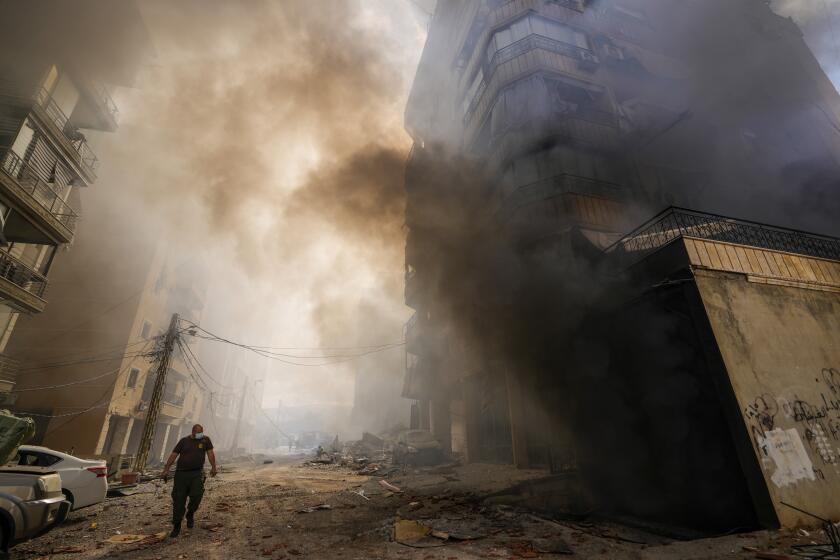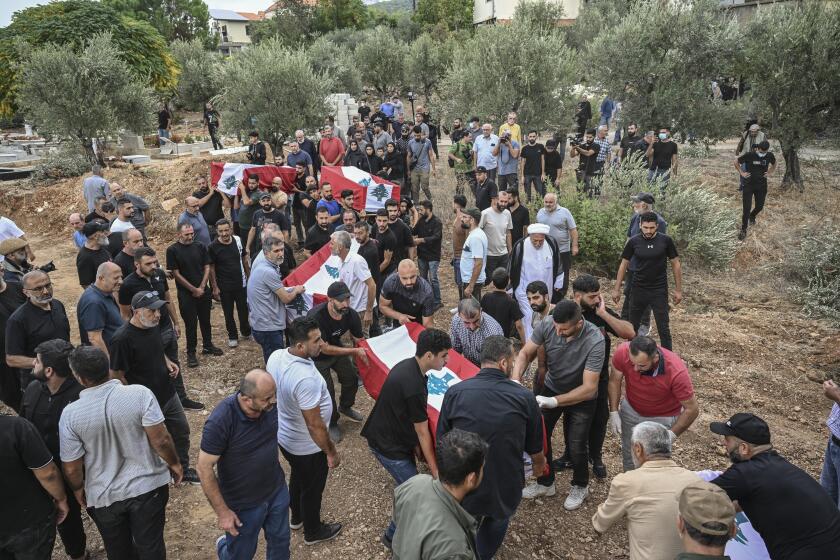Israel attacks Iran with limited retaliatory airstrikes

- Share via
- War in the Middle East escalated yet again as Israel bombed targets in Iran in a spiraling pattern of attack and retaliation that has inflamed the region.
- Israel said it was punishing the Islamic Republic for its missile barrage this month aimed at Israeli military installations and other sites,
TEHRAN — Israel bombed a range of military targets in Iran early Saturday, saying it destroyed “immediate threats” in “precise strikes” before concluding the mission. Iran claimed damage was minimal.
The pre-dawn barrage lighted up the dark sky on the horizon around Tehran as explosions thudded and smoke rose in the air. The Iranian military said two soldiers were killed but no other casualties were immediately reported.
The airstrikes were the latest in a spiraling pattern of attacks and retaliation that has inflamed the region. But Israel appears to have limited the attacks, in line with entreaties from the Biden administration, perhaps avoiding swift escalation, for now.
Israel said it was punishing the Islamic Republic for its missile barrage early this month aimed at Israeli military installations and other sites. Those attacks came in response to Israel’s assassination of the top leader of the Iran-backed Hezbollah militia and other senior commanders in Lebanon.

“We have concluded the Israeli response to Iran’s attack against Israel,” Israeli Rear Adm. Daniel Hagari said Saturday. “Our message is clear: All those who threaten the State of Israel and seek to drag the region into wider escalation will pay a heavy price. ... We are prepared, on offense and defense, to defend the State of Israel and the people of Israel.”
Israel said it hit missile-production sites and surface-to-air missile batteries.
In Tehran on Saturday, life seemed to return to a relatively normal pace. Iranians were shopping, visiting cafes or going to work and traffic was heavy.
However, Iran’s Foreign Ministry said in a statement that it, too, has a right to self-defense and “considers itself entitled and obligated to defend against foreign acts of aggression.”
As Israeli airstrikes flatten swaths of Lebanon, groups warn the attacks mirror some of the patterns of destruction and displacement seen in Gaza.
Saturday’s attacks were a rare direct confrontation between two of the most heavily armed countries in the Middle East. The enemies have instead waged a decades-long “shadow war” through proxy militias — such as the Iran-backed Lebanese group Hezbollah and the Gaza-based Palestinian militant group Hamas — or, in Israel’s case, secret sabotage missions and assassinations.
Early Saturday in Tehran, residents had reported explosions around the capital and the nearby city of Karaj. Possible targets are missile sites controlled by the Islamic Revolutionary Guard Corps on the western edge of Tehran. Smoke could also be seen near the city of Shahriyar, a reputed site of underground missile storage facilities.
In Israel, Prime Minister Benjamin Netanyahu retreated to a bunker underneath the Defense Ministry in Tel Aviv, where he was joined by Defense Minister Yoav Gallant and other senior leaders. Netanyahu’s office released a photo of the group gathered around a table.

In the weeks leading up to the attack, Biden administration officials repeatedly urged Israel to avoid targeting Iran’s oil industry — lest world markets be harmed — or its nuclear power facilities.
U.S. officials said the White House was notified by Israel in advance of the strikes. In a statement from Washington on Friday night, a National Security Council spokesman said that Israel was conducting “an exercise of self-defense and in response to Iran’s ballistic missile attack against Israel on October 1.”
Once Israel announced the mission was complete, the U.S. warned against further escalation.
Israel’s “response was an exercise in self-defense and specifically avoided populated areas and focused solely on military targets, contrary to Iran’s attack against Israel that targeted Israel’s most populous city,” said Sean Savett, a National Security Council spokesman. “It is our aim to accelerate diplomacy and de-escalate tensions in the Middle East region. We urge Iran to cease its attacks on Israel so that this cycle of fighting can end without further escalation.”
The U.S. did not participate in the Israeli operation, he added.
Iran and Israel trade threats of destruction, and Hezbollah and Israel report ‘close-quarter’ combat in Lebanon.
The strikes came a day after U.S. Secretary of State Antony J. Blinken departed the region, where he completed several days of shuttle diplomacy between Israel, Saudi Arabia and other countries in hopes of restarting cease-fire talks in the Israel-Hamas war in the Gaza Strip.

Countries in the region had been bracing for Israel’s response to Iran after Netanyahu warned Tehran would “pay a big price” for attacking Israel.
Until recently, the two countries had largely avoided direct conflict. But in a region inflamed over the last year by brutal fighting between Israel and Hamas in Gaza, Israel and Iran moved steadily closer to actual war. Tensions grew further in the last month after Israel and Hezbollah’s tit-for-tat attacks over the Israel-Lebanon border escalated drastically with the Israeli bombardment and ground invasion of Lebanon.
Israel began a ground invasion of southern Lebanon, vowing a limited operation targeting Hezbollah militants. Iran responded with a missile strike.
Just over a year ago, Hamas militants attacked southern Israel, killing about 1,200 people and seizing around 250 hostages. Israel in response launched its relentless war on the Gaza Strip. The next day, Hezbollah, announced it would step up its launching of rockets and missiles into northern Israel in solidarity with Hamas.
Israel’s military has since killed more than 42,000 Palestinians in Gaza on its southern flank, according to the Health Ministry there. Entire neighborhoods in Gaza have been destroyed, as has much of Hamas, its leaders and infrastructure. On Oct. 18, Israel announced it had killed the senior leader of Hamas, Yahya Sinwar.
By then, Israel had shifted major military operations to its northern border with Lebanon. From inside Lebanon over the last 12 months, Hezbollah had been firing thousands of rockets and missiles into Israel, driving some 70,000 Israelis from their towns and killing a small number. Israel’s strikes on Lebanon had also displaced tens of thousands, until Israel’s expanded bombardments in late September.
As Israel expands its strikes far from Hezbollah’s bastions into areas where displaced Shiites have fled, fears rise about worsening sectarian tensions.
On Sept. 30, Israel launched its first ground invasion of Lebanon in 18 years and said it was attacking Hezbollah targets. But its bombardments expanded across Lebanon, to the Bekaa Valley and even Tripoli in the north while repeatedly pounding the capital, Beirut. More than 2,000 Lebanese have been killed and a million displaced, according to the Lebanese health ministry.
Hezbollah is Iran’s most important proxy in the Middle East. And Israel’s assassination of the militant group’s longtime leader, Hassan Nasrallah on Sept. 27 triggered Iran’s retaliation four days later — a barrage of nearly 200 ballistic missiles that forced millions of Israelis into bomb shelters.
Backed by the U.S. and British air forces, Israel was able to intercept most of the projectiles. Still, it was only the second time Iran had attacked Israel directly, the first being in April; both times, the damage in Israel was minimal.
Israel vowed retaliation, and the region had been bracing for that ever since.
U.S.-led efforts to broker a Gaza cease-fire — aimed at freeing the remaining hostages held in Gaza, stopping the Israeli bombardment and making possible the delivery of desperately needed food and medicine — have failed thus far.
Times staff writer Wilkinson reported from Washington, special correspondent Mostaghim from Tehran. Staff writer Laura King in Washington contributed to this report.
More to Read
Sign up for Essential California
The most important California stories and recommendations in your inbox every morning.
You may occasionally receive promotional content from the Los Angeles Times.















